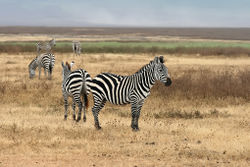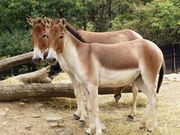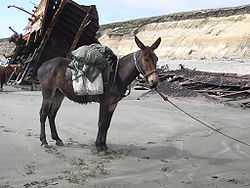Equus (genus)
| Equus Fossil range: 1.8–0 Ma Early Pleistocene to Recent |
|
|---|---|
 |
|
| Plains Zebras | |
| Scientific classification | |
| Kingdom: | Animalia |
| Phylum: | Chordata |
| Class: | Mammalia |
| Order: | Perissodactyla |
| Family: | Equidae Gray, 1821 |
| Genus: | Equus Linnaeus, 1758 |
| Species | |
|
E. africanus - African Wild Ass |
|
Equus is a genus of animals in the family Equidae that includes horses, donkeys, and zebras. Within Equidae, Equus is the only extant genus. Like Equidae more broadly, Equus has numerous extinct species known only from fossils. This article deals primarily with the extant species.
The term equine refers to any member of this genus, including any horse. The word comes from Latin equus, "horse"[1], cognate with Greek "ἴκκος" (ikkos), "horse"[2] (the earliest form of the word is the Mycenaean Greek i-qo, written in Linear B syllabic script[3]).
Contents |
Characteristics
Equines are medium to large mammals, with long heads, and necks with a mane. Their legs are slender and end in a single, unguligrade toe, protected by a horny hoof. They have long, slender, tails, either ending in a tuft, or entirely covered in flowing hair. They are adapted to generally open terrain, from plains and savannas, to mountains or deserts.

The pinnae ("ears") of equines are mobile, enabling them to easily localise the origin of sounds. They have two-color, or dichromatic vision. Their eyes are set back far on the head, giving them a wide angle of view, without entirely losing binocular vision. Equines also have a vomeronasal organ, that allows males to use the flehmen, or 'lip-curling' response to assess the sexual state of potential mates.
Equines are herbivores, and feed predominantly on tough, fibrous food, such as grasses and sedges. When in need, they will also eat other vegetable matter, such as leaves, fruits, or bark, but are normally grazers, not browsers. Unlike ruminants, with their complex stomachs, equines break down cellulose in the "hindgut" or cecum, a part of the colon. Their dentition is almost complete, with cutting incisors to crop food, and grinding molars set well back behind a diastema. The dental formula for equines is:
| Dentition |
|---|
| 3.1.3-4.3 |
| 3.1.3.3 |

Equines are social animals, living in herds or bands. Horses, along with Plains and Mountain Zebras, have permanent herds generally consisting of a single male and a band of females, with the remaining males forming small "bachelor" herds. The remaining species have temporary herds, lasting only a few months, which may be either single-sexed or mixed. In either case, there are clear hierarchies established amongst the individuals, usually with a dominant female controlling access to food and water resources and the lead male controlling mating opportunities.
Females, usually called mares in horses and zebras, or, in the case of asses and donkeys, jennys, usually bear a single foal, after a gestation period of approximately 11 months. Young equines are able to walk within an hour of birth, and are weaned after four to thirteen months (animals living in the wild naturally wean foals at a later date than those under domestication). Depending on species, living conditions and other factors, females in the wild may give birth every year or every other year.[4][5]
Equines who are not in foal generally have a seasonal estrous cycle, from early spring into autumn. Most females enter an anestrus period during the winter and thus do not cycle in this period. The reproductive cycle is controlled by the photoperiod (length of the day), with estrus triggered when the days begin to lengthen. Anestrus prevents the female from conceiving in the winter months, as that would result in her foaling during the harshest part of the year, a time when it would be more difficult for the foal to survive.[6] However, equines who live near the equator, where there is less change in length of day from season to season, have no anestrus period, at least in theory.[7] Further, for reasons that are not clear, about twenty percent of domestic mares in the Northern Hemisphere will cycle the year round.[8]
Classification
see also: Evolution of the horse
Family Equidae (in addition to Equus, the family includes approximately 35 other genera, all extinct)
- Genus Equus
- Subgenus Equus
- Equus ferus Wild Horse[9][10]
- Equus ferus caballus Domestic horse
- †Equus ferus ferus Tarpan (historically extinct)
- Equus ferus przewalskii Przewalski's Horse or Mongolian Wild Horse
- †Equus algericus (Pleistocene of Algeria)
- † North American caballid horses (Pleistocene; most likely synonymous with E. ferus):
- †Equus lambei Yukon Wild Ass (or Yukon Wild Horse)
- †Equus niobrarensis
- Subgenus †Amerhippus Hoffstetter, 1950 (jr synonym subgenus Tomolabis Cope, 1892) (this subgenus and the species therin are possibly synonymous with E. ferus)[11]
- †Equus andium
- †Equus neogeus
- †Equus fraternus Leidy, 1860 (North America)
- †Equus santaeelenae
- †Equus scotti Owen
- †Equus niobrarensis
- †Equus conversidens Owen, 1863 ("Mexican Horse") (North America)
- †New World stilt-legged horse (all following species within the group may be synonyms or regional races of a single species)[12]
- †Equus francisci Hay, 1915
- †Equus semiplicatus Cope, 1893 (North America)
- Equus ferus Wild Horse[9][10]
- Subgenus Asinus
- Equus africanus African Wild Ass[10][13]
- Equus africanus africanus Nubian Wild Ass
- Equus africanus asinus Domestic Donkey, Ass or Burro
- †Equus africanus atlanticus Atlas Wild Ass
- Equus africanus somalicus Somali Wild Ass
- Equus hemionus Onager or Asiatic Ass
- Equus hemionus hemionus Mongolian Wild Ass, Dziggetai or Gobi Kulan
- †Equus hemionus hemippus Syrian Wild Ass
- Equus hemionus khur Indian Wild Ass or Khur
- Equus hemionus kulan Turkmenian Kulan
- Equus hemionus onager Persian Onager
- Equus kiang Kiang
- Equus kiang chu Northern Kiang
- Equus kiang kiang Western Kiang
- Equus kiang holdereri Eastern Kiang
- Equus kiang polyodon Southern Kiang
- †Equus hydruntinus European Ass (late Paleolithic of southern Europe)
- †Equus altidens (middle Pleistocene of Tadjikistan)
- †Equus tabeti (early middle Pleistocene of Algeria, known only from teeth and limb bones)
- †Equus melkiensis (late Paleolithic of Algeria, based on teeth and limb bones)
- †Equus graziosii (late Pleistocene of Italy)
- Equus africanus African Wild Ass[10][13]
- Subgenus Dolichohippus
- Equus grevyi Grevy's Zebra
- †Equus koobiforensis Eisenmann, 1983 (East Africa, ~2 million years (late Pliocene), similar but more derived than E.simplicidens and E.sanmeniensis
- †Equus oldowayensis Hopwood, 1937 (East Africa, late Pleiocene, early Pleistocene, likely conspecific with E.koobiforensis
- Subgenus Hippotigris
- Equus quagga Plains Zebra
- Equus quagga boehmi Grant's Zebra
- Equus quagga borensis Selous' zebra
- Equus quagga chapmani Chapman's Zebra
- Equus quagga crawshayi Crawshay's Zebra
- Equus quagga burchellii Burchell's Zebra
- †Equus quagga quagga Gmelin, 1788 Quagga (South Africa, extinction in early 20th century)
- Equus zebra L.,1758 Mountain Zebra
- Equus zebra hartmannae Hartmann's Mountain Zebra
- Equus zebra zebra Cape Mountain Zebra
- †Equus mauritanicus Pomel, 1897 (Pleistocene transitional form between E. (Dolichohippus) and E. (Hippotigris), possibly via E.koobiforensis)
- Equus quagga Plains Zebra
- Subgenus †Parastylidequus
- †Equus parastylidens Mooser’s Horse
- incertae sedis
- †Equus simplicidens Hagerman Horse (North American Pleiocene - earliest known species of genus Equus) (perhaps closest to Dolichohippus[14])
- †Equus cumminsii Cope, 1893 (North America; based on a single, 3 million year old tooth)
- †Equus livenzovensis Baihusheva, 1978 (southern Russia and western Europe, Pleiocene - highly similar to E. simplicidens
- †Equus sanmeniensis Teilhard&Piveteau, 1930 (south China, late? Pliocene; similar but more derived than E.livenzovensis
- †Equus teilhardi Eisenmann, 1975 (south China, late(?) Pliocene; similar to E.sanmeniensis but smaller, likely synonym)
- †Equus numidicus Pomel, 1897
- †Equus plicidens Owen, 1844 (late Pliocene, only teeth known)
- †Equus stenonis group
- †Equus stenonis Cocchi, 1867 (Europe to China, late Pleiocene)
- †Equus stenonis vireti (late Pliocene)
- †Equus stenonis senezensis (late Pliocene)
- †Equus stenonis guthi (late Pliocene, France)
- †Equus stenonis pamirensis (=Hippotigris pamirensis) (late Pliocene, central Asia)
- †Equus sivalensis (late Pleiocene (?), India; similar to E.stenonis in skull shape)
- †Equus stehlini (early Pleistocene, ~1 million years ago; similar but smaller than E. stenonis
- †Equus bressanus (early Pleistocene, ~1 million years ago; similar but much larger than E. stenonis
- †Equus sussenbornensis Wüst, 1901 (early middle Pleistocene of Europe)
- †Equus verae Sher, 1971 (middle Pleistocene of north eastern Asia)
- †Equus namadicus (middle paleolithic sites in India)
- †Equus stenonis Cocchi, 1867 (Europe to China, late Pleiocene)
- †subgenus Allozebra & Hesperohippus (N. American lineage of middle to late Pleistocene)
- †Equus idahoensis
- †Equus (A.) occidentalis
- †Equus (A.) excelsus
- †Equus (H.) pacificus
- †Equus complicatus
- †Equus fraternus
- Equus major Boule (nomen dubium)
- †Equus giganteus group
- †Equus giganteus
- †Equus pectinatus
- †Equus crinidens
- Subgenus Equus
 Przewalski's Horse, the only remaining type of "wild" horse that has never been domesticated |
 A domesticated horse |
 A donkey |
An onager, one type of wild ass |
 A pair of kiangs |
 Quagga (now extinct) |
 Plains zebra |
 Grévy's zebra |
 Equus conversidens (extinct) |
Cross-breeds
Different species of Equus can crossbreed, though the ensuing offspring are usually infertile. Hybrids include:

- Mule, a cross between a male donkey and a female horse. Mules are the most common type of hybrid equine and are renowned for their toughness, surefootedness, and working ability.
- Hinny, a cross between a female donkey and a male horse. Considered a less desirable cross than a mule, generally smaller in size and not as hardy.
- Zeedonk or Zonkey, a cross between a donkey and a zebra.
- Zony, a zebra/pony cross.
- Zorse or zebrula, the offspring of a zebra stallion and a horse mare; the rarer reverse pairing is sometimes called a hebra.
Any equine with partial zebra ancestry is also called a zebroid.
See also
- Domestication of the horse
References
- ↑ equus, Charlton T. Lewis, Charles Short, A Latin Dictionary, on Perseus Digital Library
- ↑ ἴκκος, Henry George Liddell, Robert Scott, A Greek-English Lexicon, on Perseus Digital Library
- ↑ Palaeolexicon, Word study tool of ancient languages
- ↑ Macdonald, D., ed (1984). The Encyclopedia of Mammals. New York: Facts on File. pp. 482–485. ISBN 0-87196-871-1.
- ↑ "ENVIRONMENTAL ASSESSMENT: PRYOR MOUNTAIN WILD HORSE RANGE FY2004: FERTILITY CONTROL ON AGE-SPECIFIC WILD HORSE MARES." BLM National Research Field Trials on Wild Horse Fertility Control, Summer 2004 Web page accessed November 21, 2007
- ↑ Ensminger, M. E. Horses and Horsemanship: Animal Agriculture Series. Sixth Edition. Interstate Publishers, 1990. ISBN 0-8134-2883-1 p. 156
- ↑ Eilts, Bruce E. "Aberrations of the Equine Estrous cycle," Louisians State University school of Veterinary Medicine, last modified 15 August 2007. Web page accessed November 21, 2007
- ↑ Id.
- ↑ Don E. Wilson & DeeAnn M. Reeder, ed (2005). "Equus caballus". Mammal Species of the World. A Taxonomic and Geographic Reference (3rd ed.). Johns Hopkins University Press. http://www.bucknell.edu/msw3/browse.asp?s=y&id=14100015.
- ↑ 10.0 10.1 International Commission on Zoological Nomenclature (2003). "Usage of 17 specific names based on wild species which are pre-dated by or contemporary with those based on domestic animals (Lepidoptera, Osteichthyes, Mammalia): conserved. Opinion 2027 (Case 3010).". Bull.Zool.Nomencl. 60 (1): 81–84. http://www.iczn.org/BZNMar2003opinions.htm#opinion2027.
- ↑ Orlando, L.; et al. (2008). "Ancient DNA Clarifies the Evolutionary History of American Late Pleistocene Equids". Journal of Molecular Evolution 66 (5): 533–538. doi:10.1007/s00239-008-9100-x. PMID 18398561.
- ↑ Weinstock, J.; et al. (2005). "Evolution, systematics, and phylogeography of Pleistocene horses in the New World: a molecular perspective". PLoS Biology 3 (8): e241. doi:10.1371/journal.pbio.0030241. PMID 15974804. PMC 1159165. http://biology.plosjournals.org/perlserv/?request=get-document&doi=10.1371%2Fjournal.pbio.0030241&ct=1. Retrieved 2008-12-19.
- ↑ Don E. Wilson & DeeAnn M. Reeder, ed (2005). "Equus asinus". Mammal Species of the World. A Taxonomic and Geographic Reference (3rd ed.). Johns Hopkins University Press. http://www.bucknell.edu/msw3/browse.asp?s=y&id=14100004.
- ↑ Hagerman Fossil Beds NM Hourse Quarry Page
Sources
- Burke, et al. 2003. The systematic position of Equus hydruntinus, an extinct species of Pleistocene equid. Quaternary Research 59(3):459-469.
- Duncan, P. (ed.). 1992. Zebras, Asses, and Horses: an Action Plan for the Conservation of Wild Equids. IUCN/SSC Equid Specialist Group. IUCN, Gland, Switzerland.
- Equid Specialist Group 1996. Equus ferus. In: IUCN 2004. 2004 IUCN Red List of Threatened Species. <www.iucnredlist.org>. Downloaded on 21 January 2006.
- Equid Specialist Group 1996. Equus ferus ssp. przewalskii. In: IUCN 2004. 2004 IUCN Red List of Threatened Species. <www.iucnredlist.org>. Downloaded on 21 January 2006.
- Groves, C.P. & Bell, H.B. 2004. New investigations on the taxonomy of the zebras genus Equus, subgenus Hippotigris. Mammalian Biology. 69: 182-196.
- Higuchi et al. 1987. Mitochondrial DNA of the Extinct Quagga: Relatedness and Extent of Postmortem Change. Journal of Molecular Evolution 25:283-287.
- International Commission on Zoological Nomenclature. 2003. Opinion 2027 (Case 3010). Usage of 17 specific names based on wild species which are pre-dated by or contemporary with those based on domestic animals (Lepidoptera, Osteichthyes, Mammalia): conserved. Bull.Zool.Nomencl., 60:81-84.
- Moehlman, P.D. 2002. Equids. Zebras, Assess and Horses. Status Survey and Conservation Action Plan. IUCN/SSC Equid Specialist Group. IUCN, Gland, Switzerland. (http://www.iucn.org/themes/ssc/publications/actionplans.htm#Equids2002)
- Orlando, et al. 2006. Geographic distribution of an extinct equid (Equus hydruntinus : Mammalia, Equidae) revealed by morphological and genetical analyses of fossils. Molecular Ecology 15(8):2083-2093.
|
||||||||||||||||||||||||||||||||||||||||||
|
|||||||||||||||||
|
||||||||||||||||||||||||||||
.jpg)